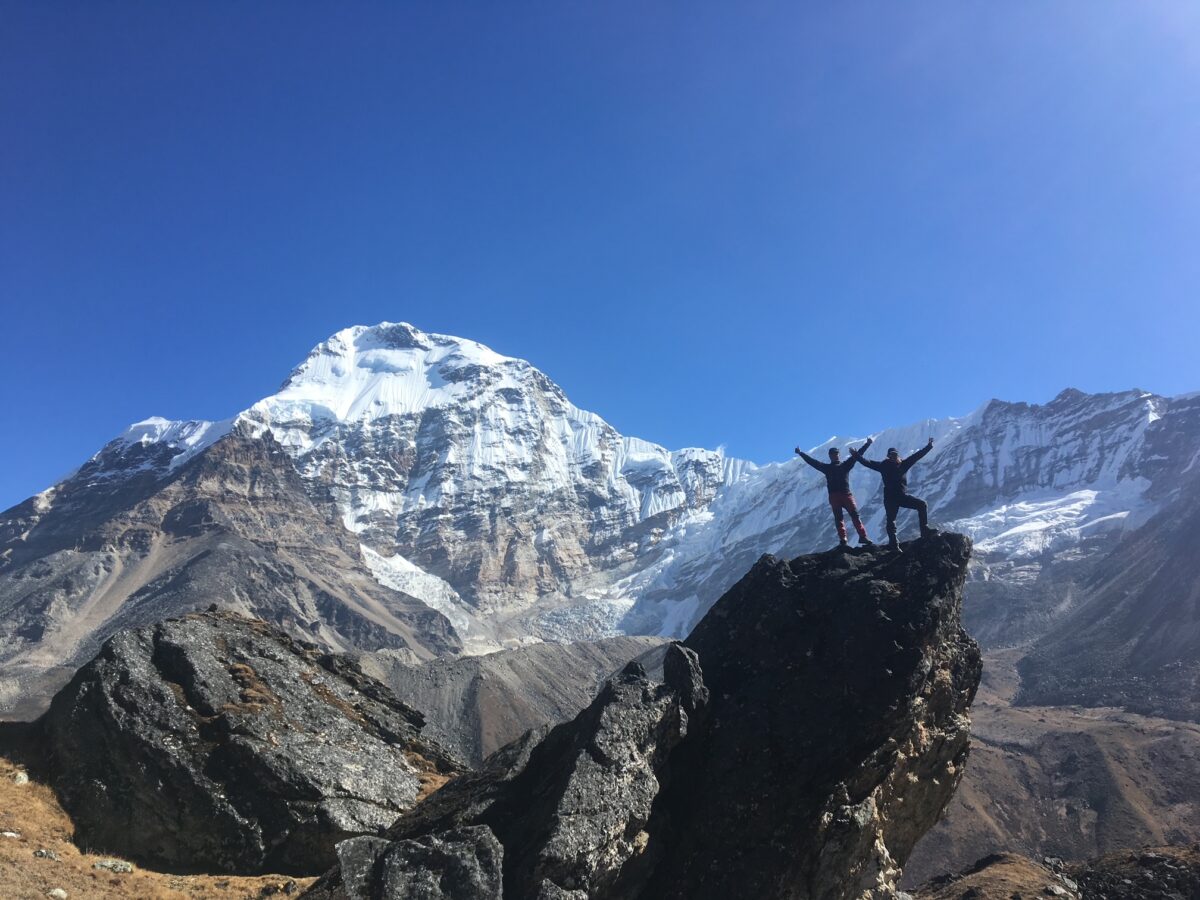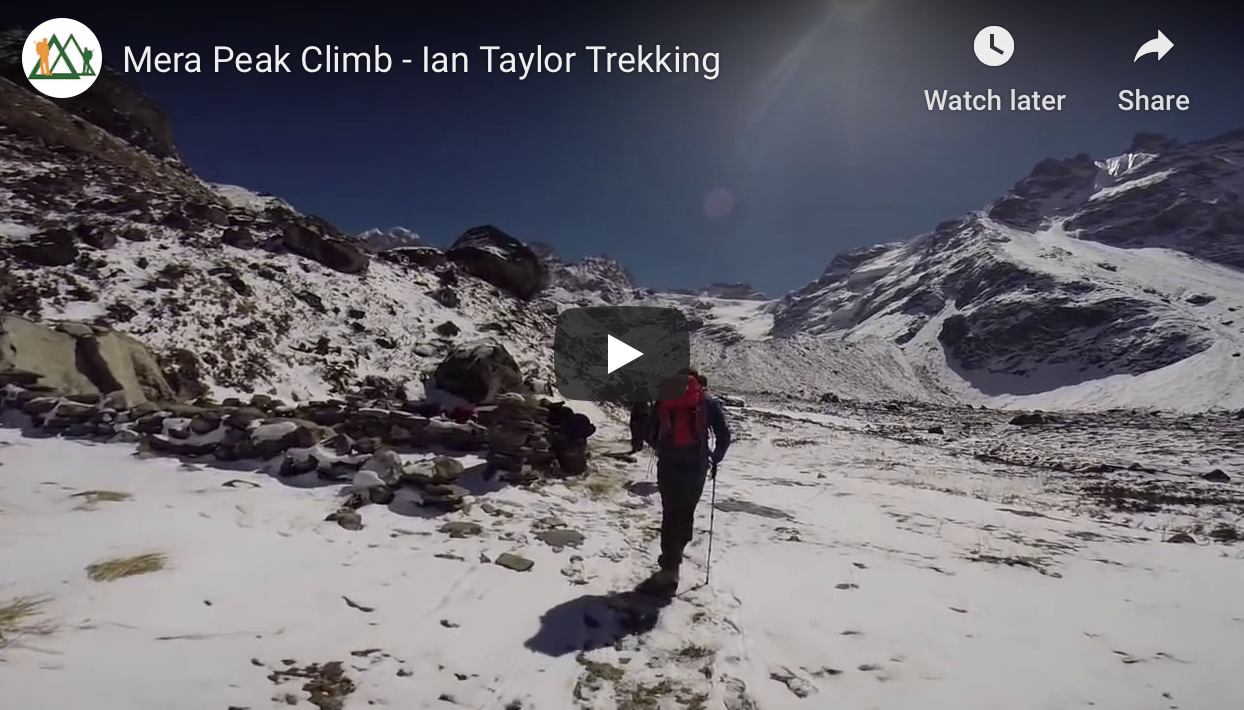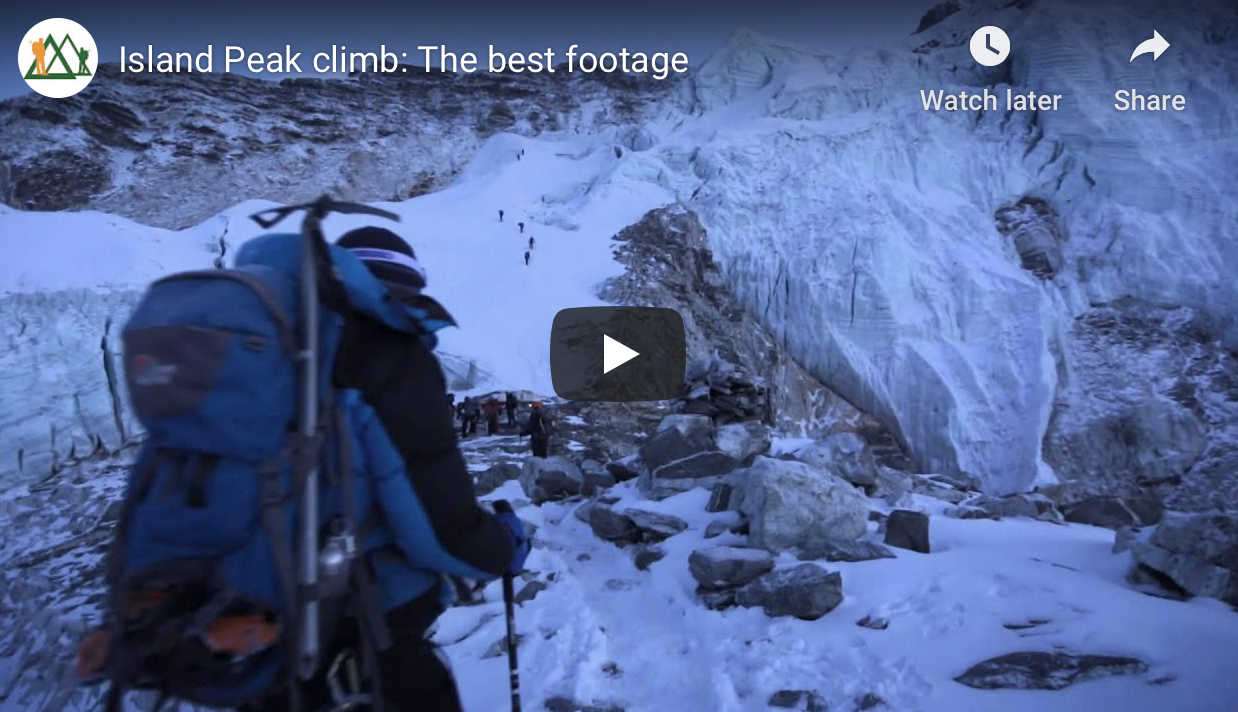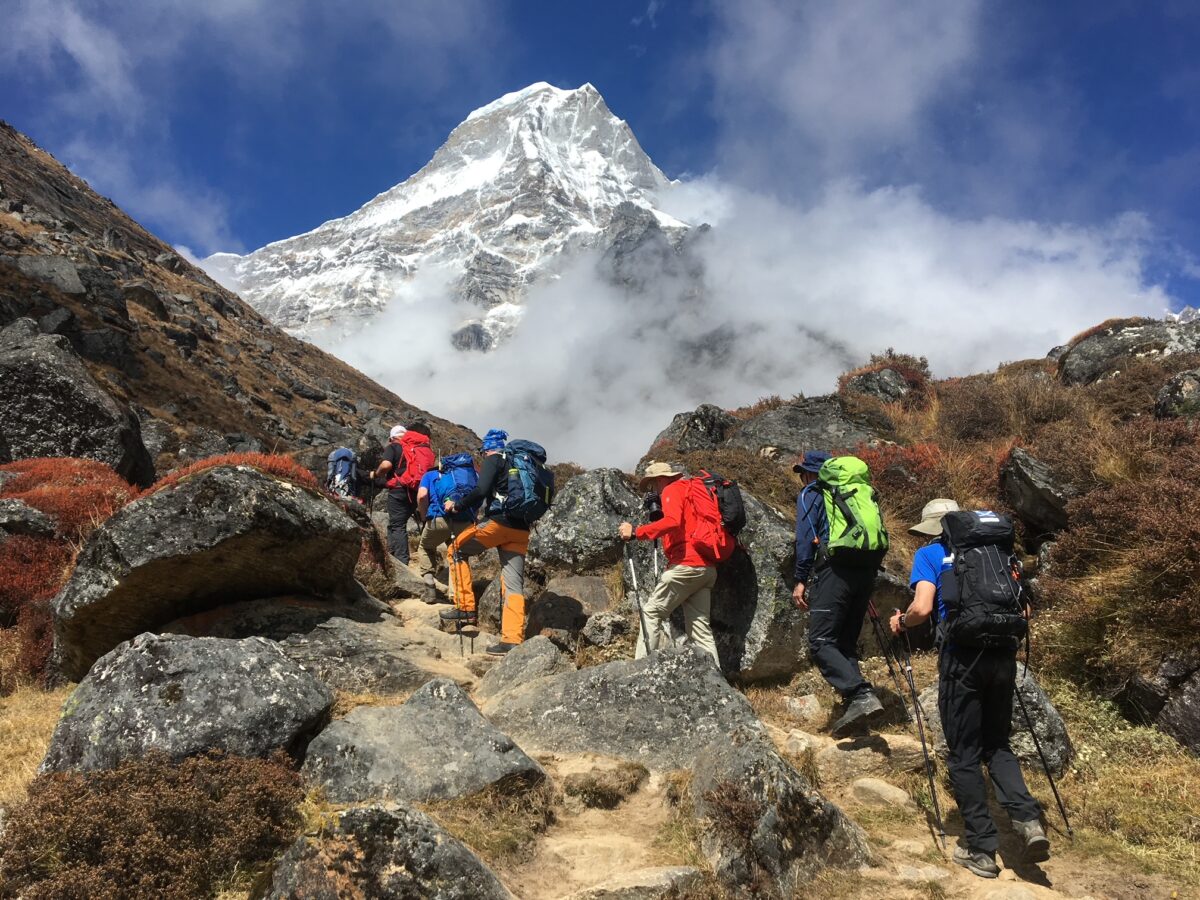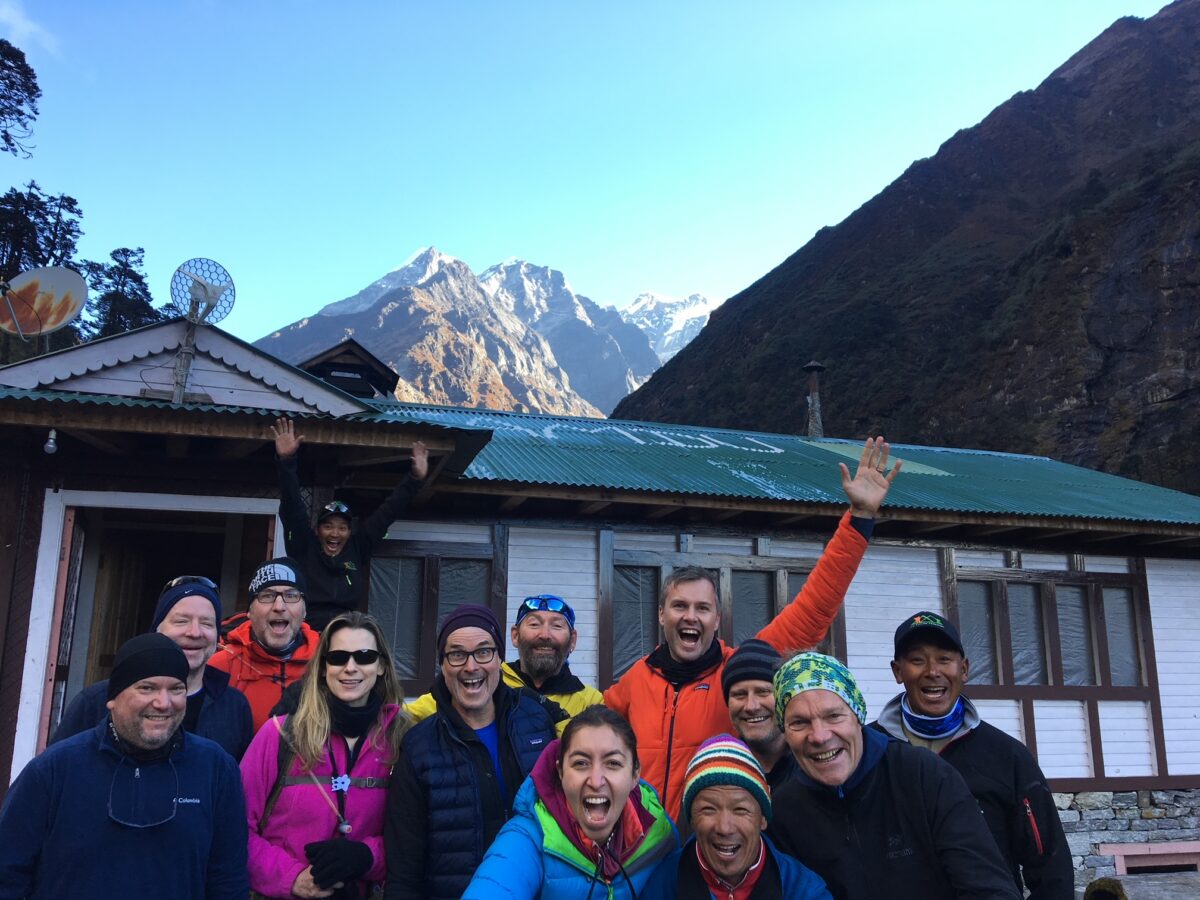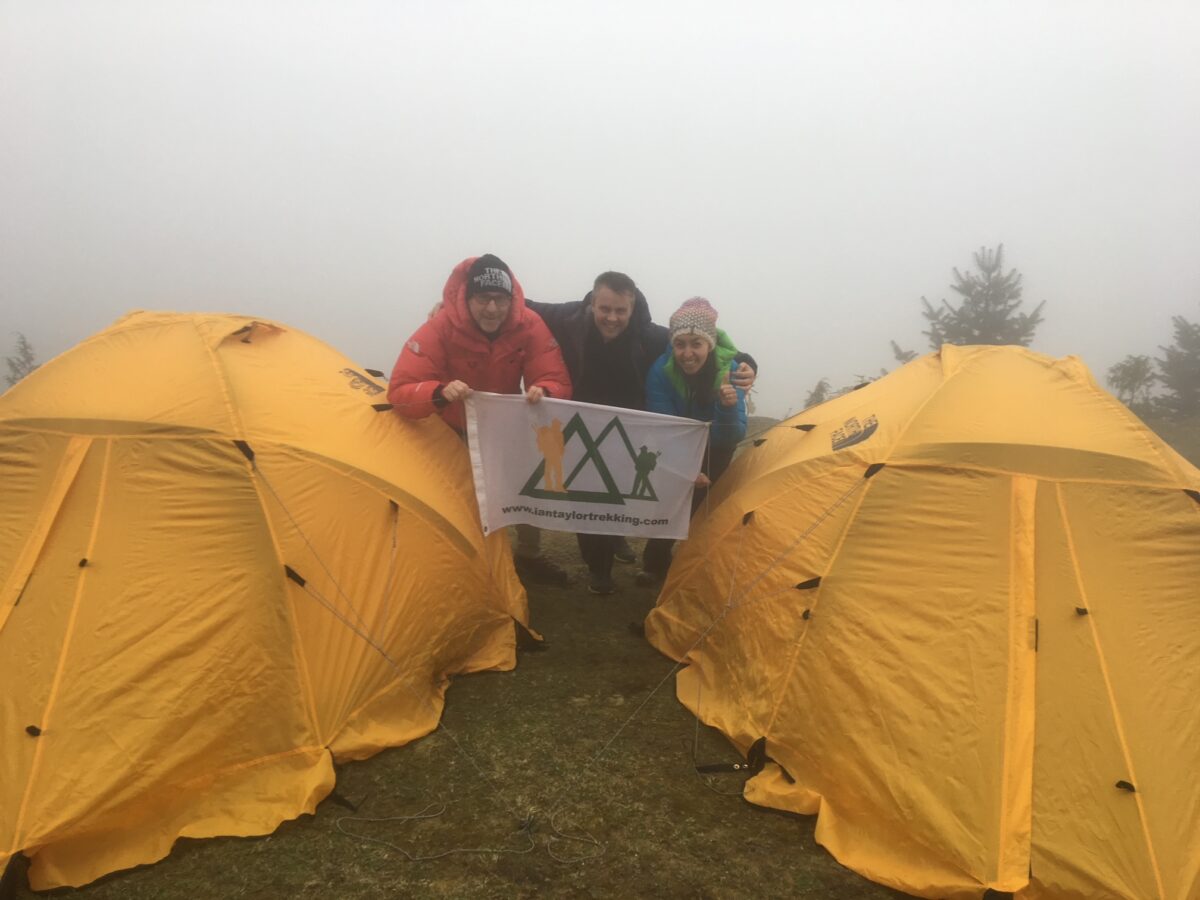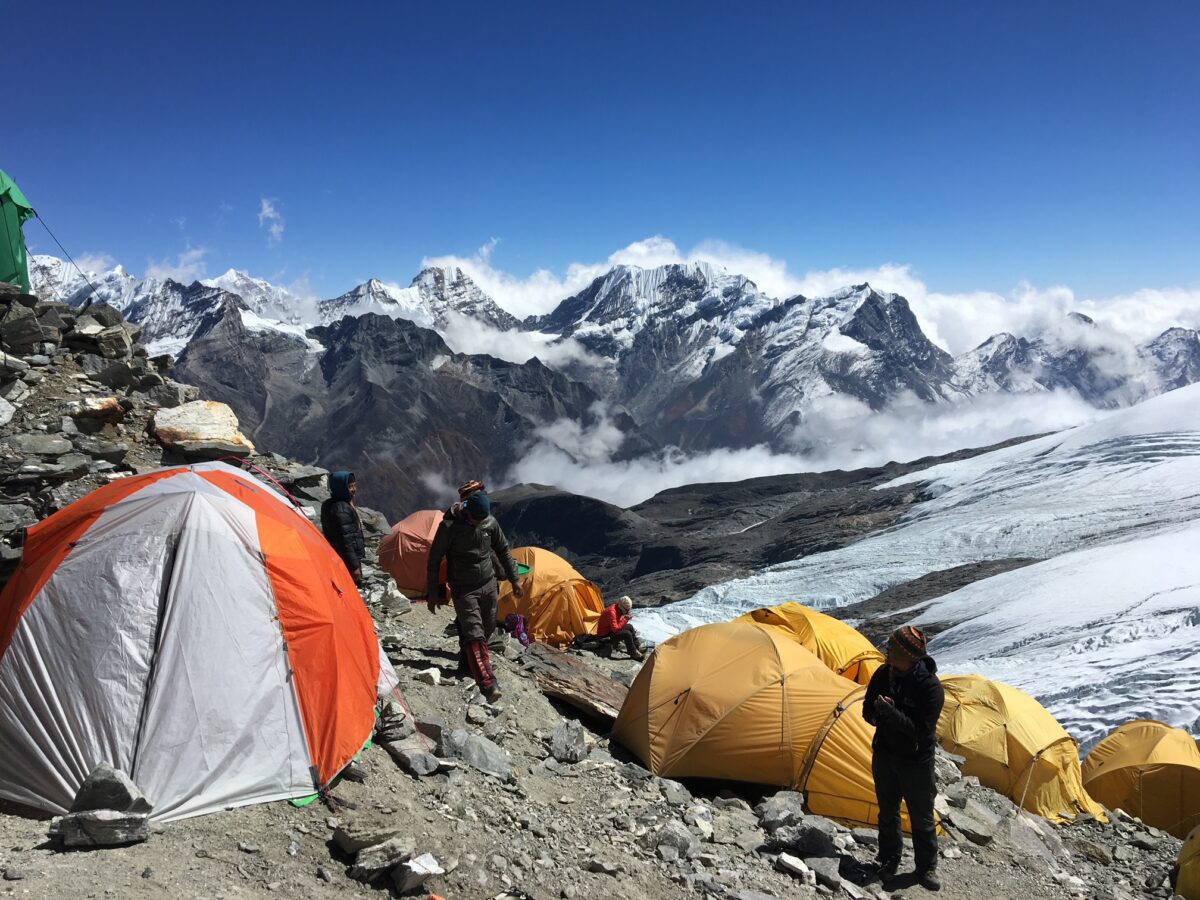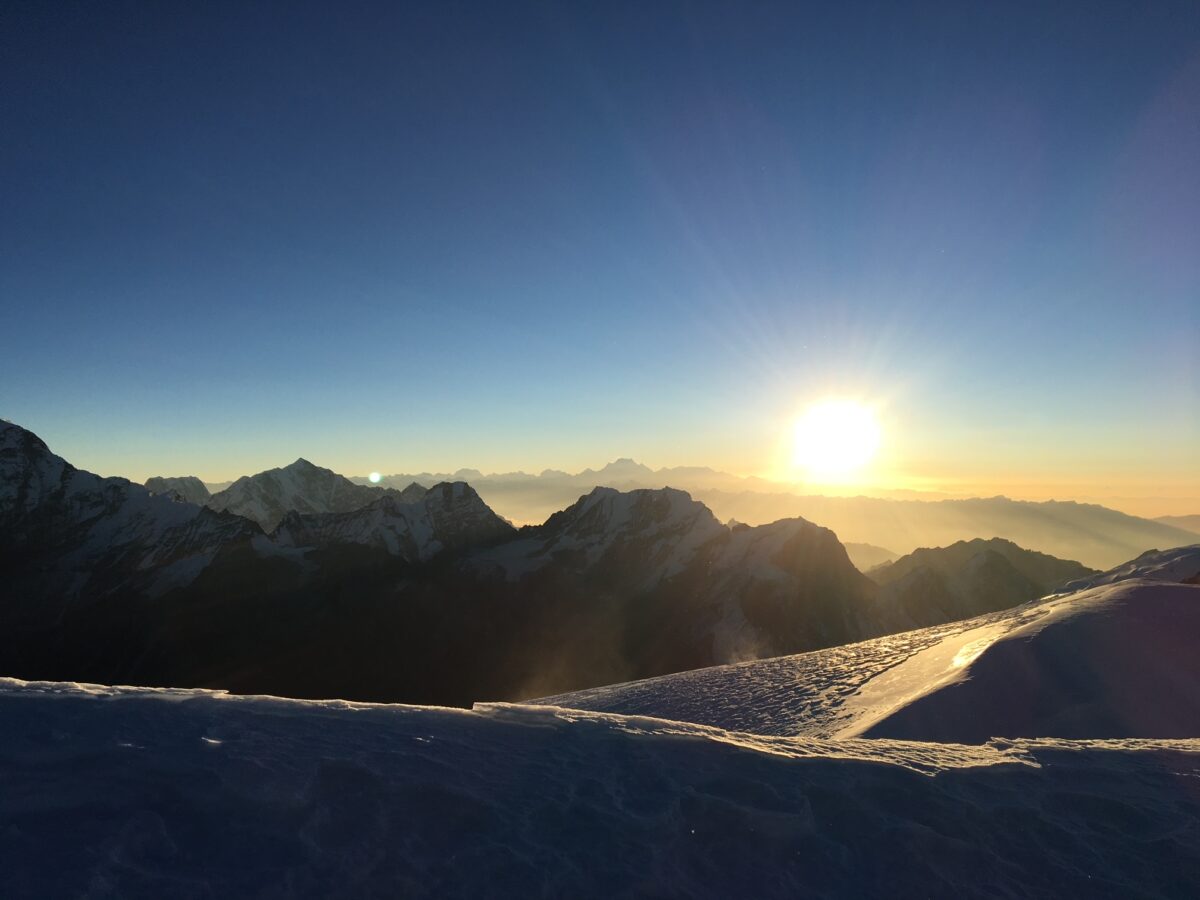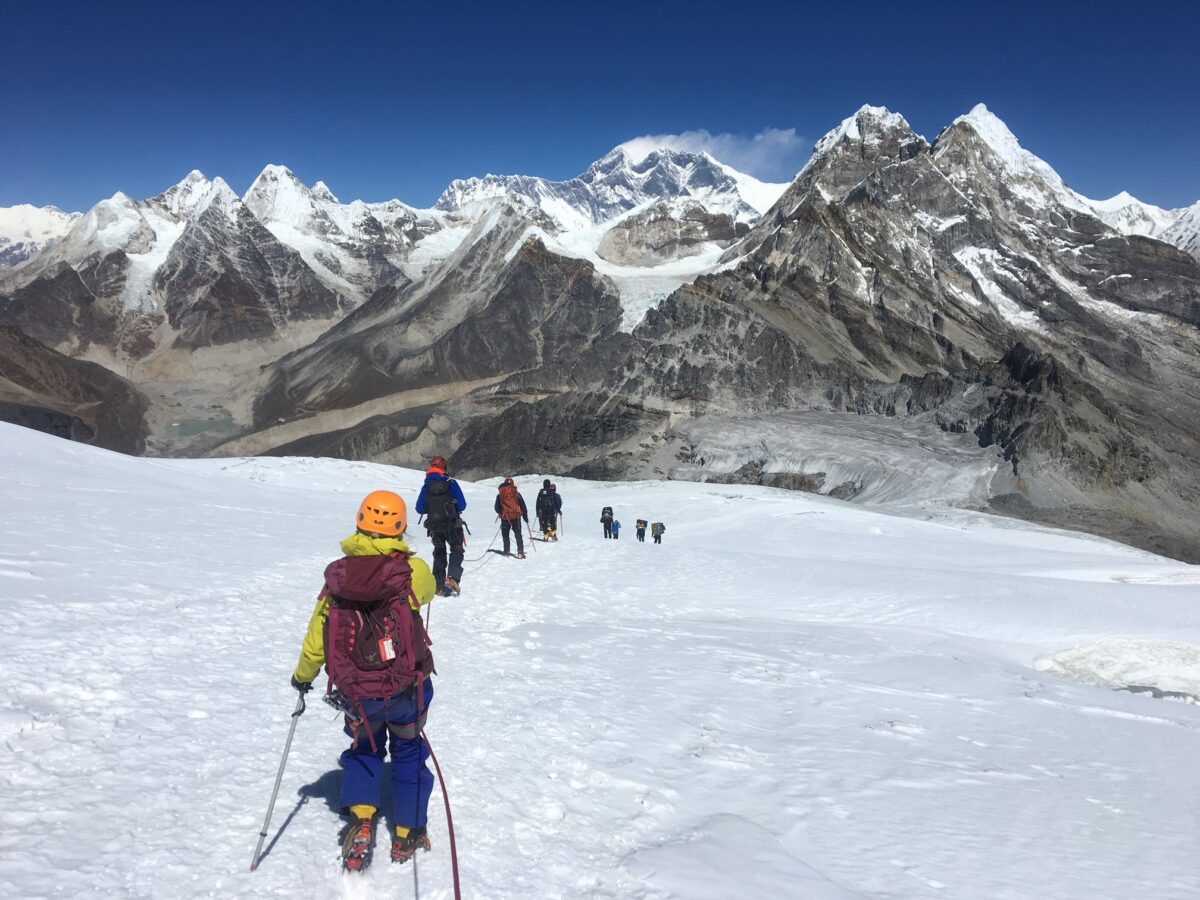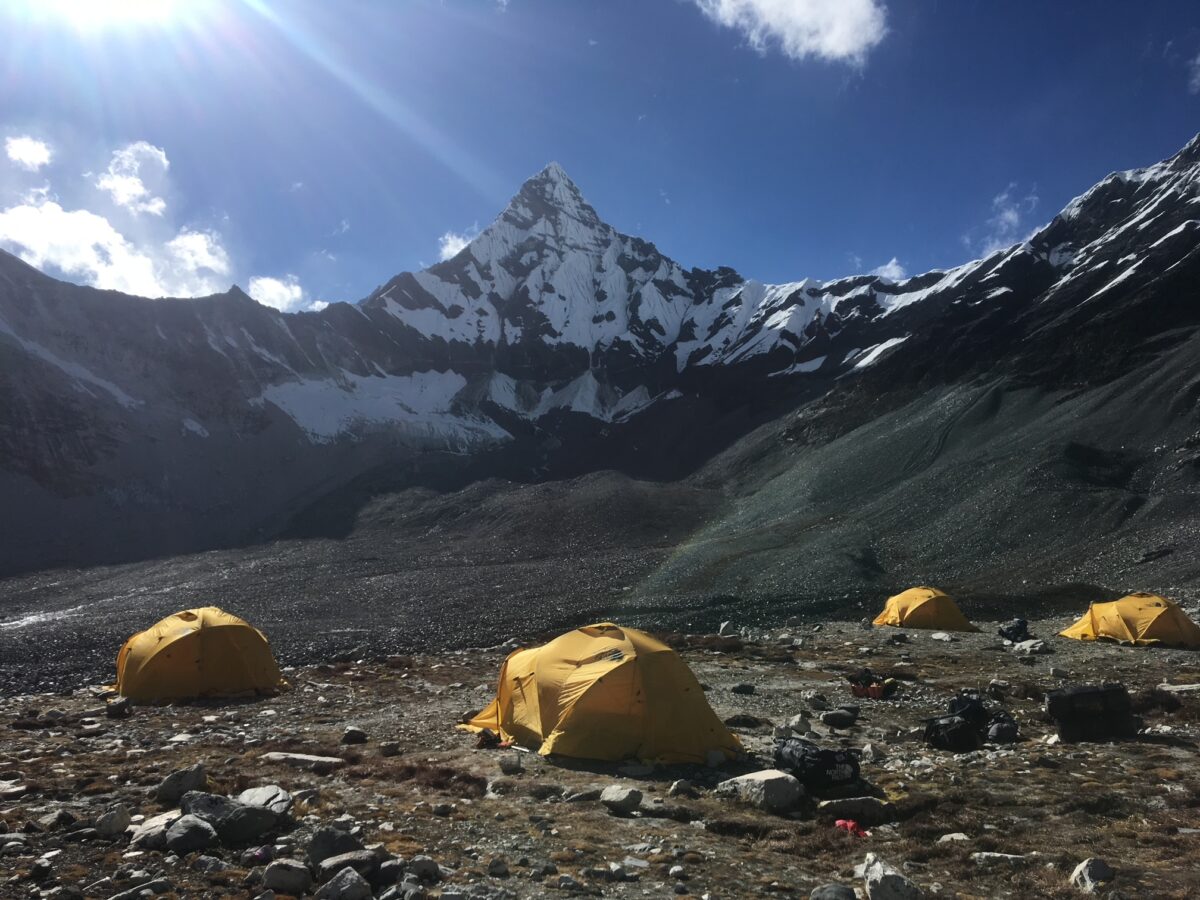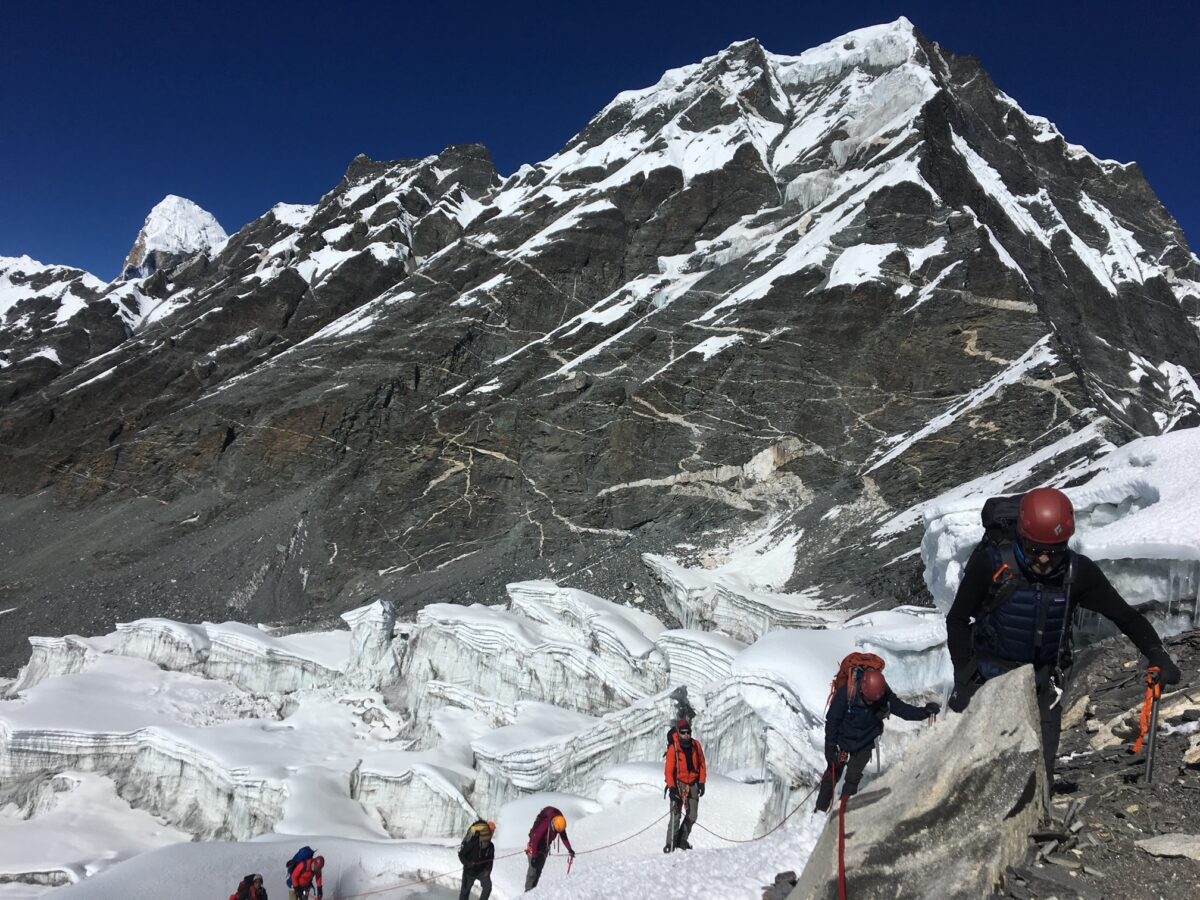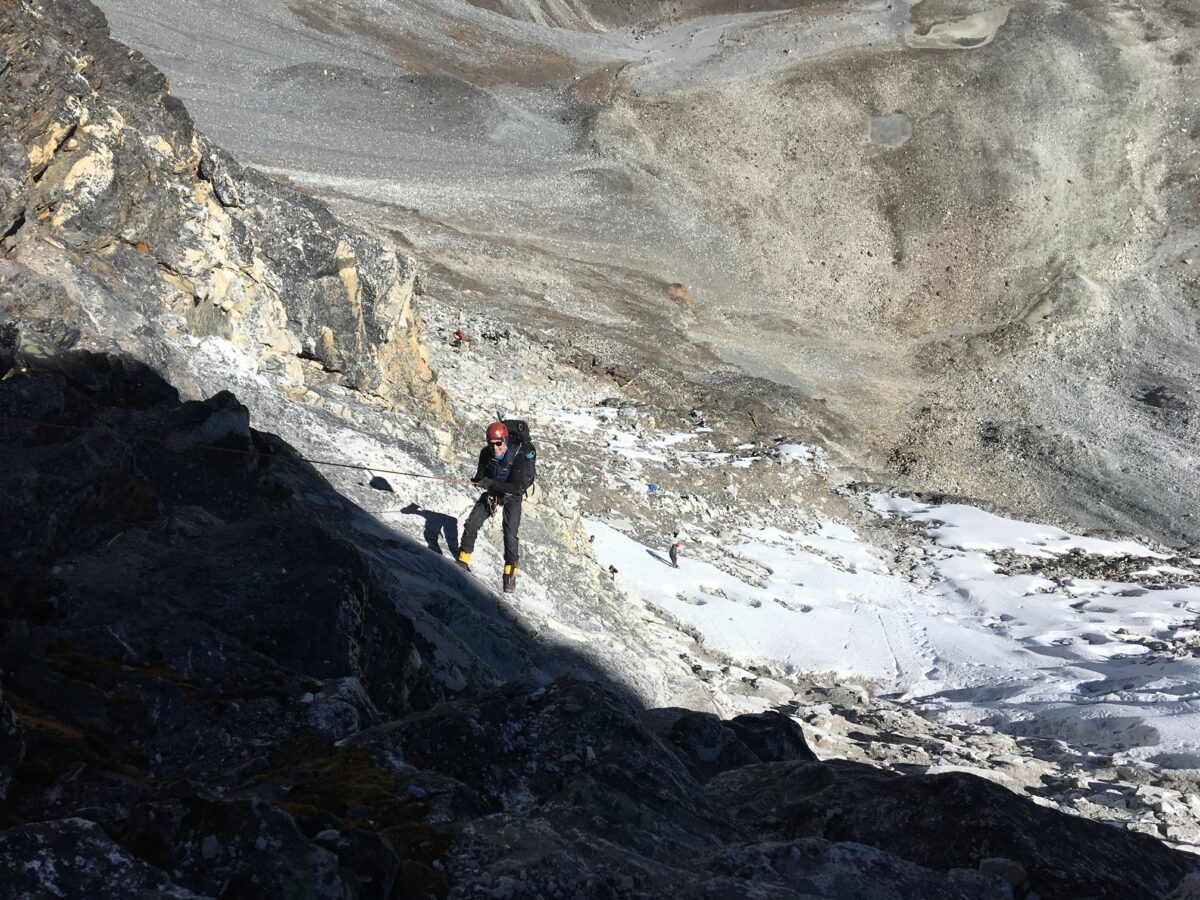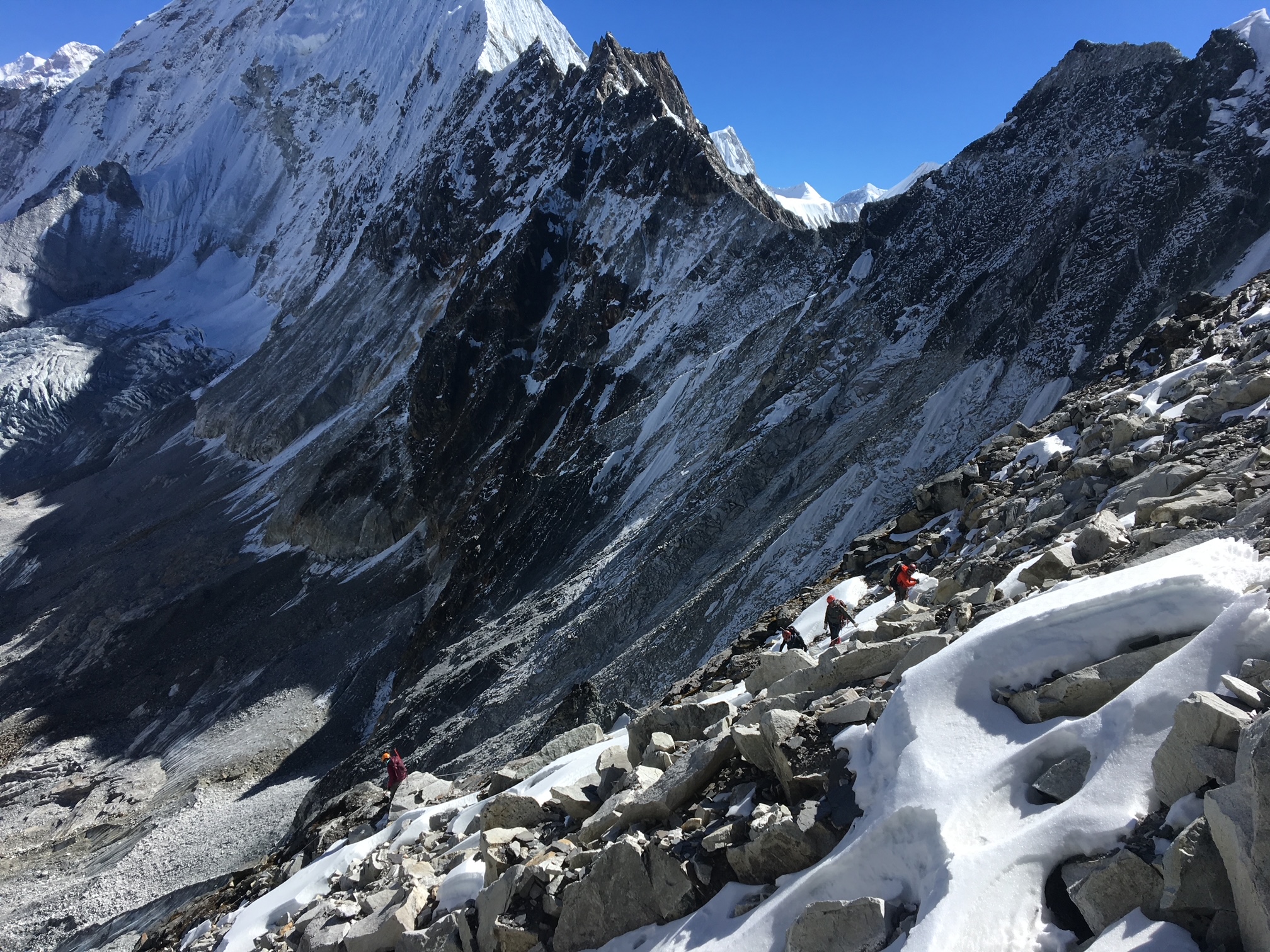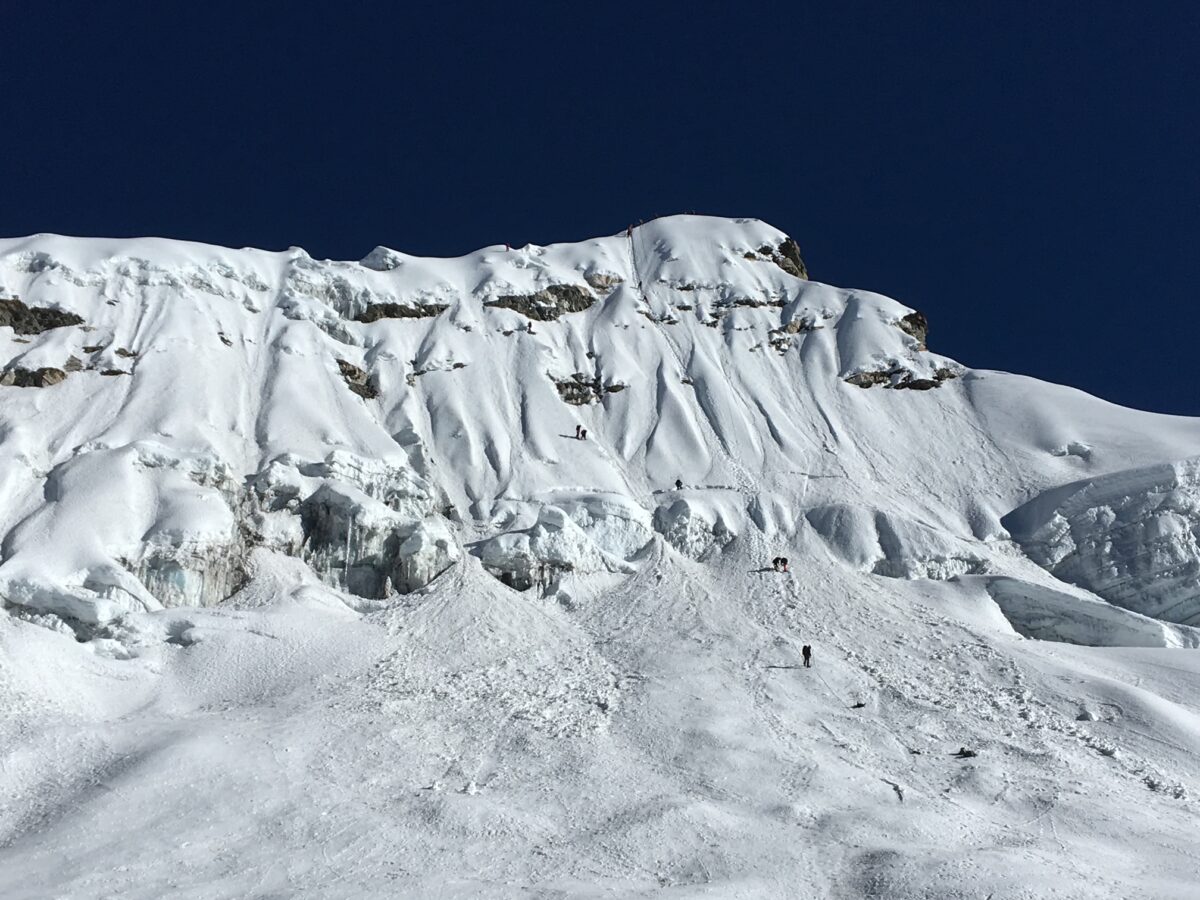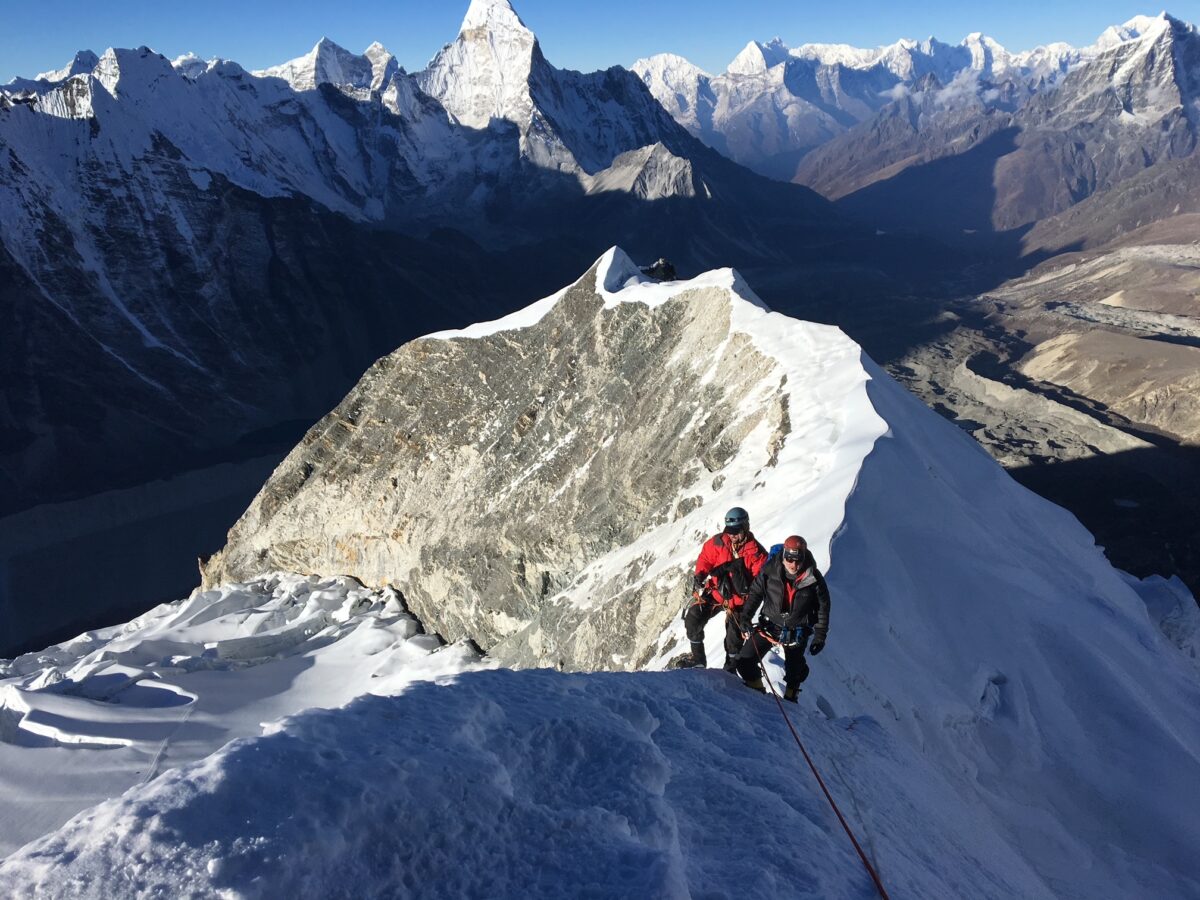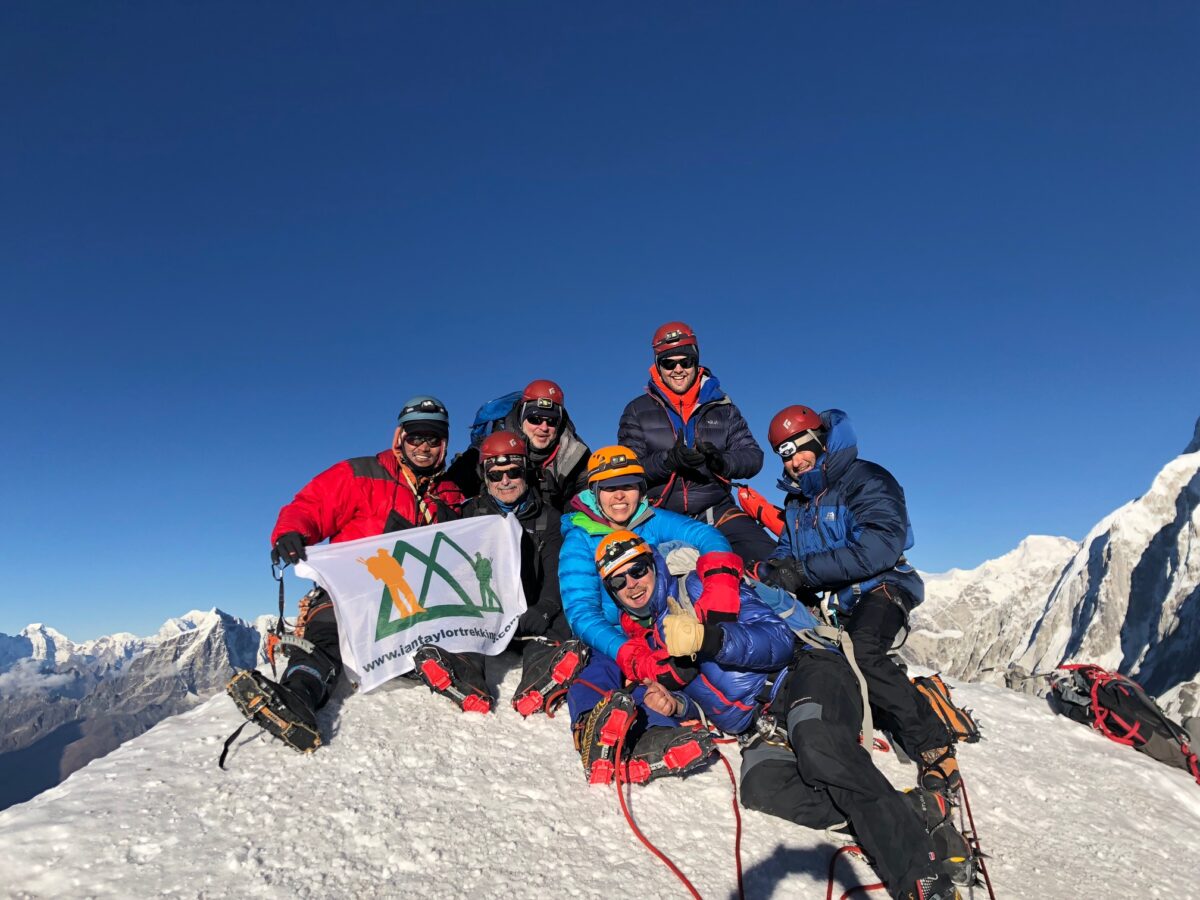Mera and Island Peaks
The fantastic vista from the summit of Mera peak, includes views of Kanchenjunga, Makalu, Everest, Lhotse, Ama Dablam, and Cho Oyu. From the summit, we will descend into the beautiful Hongu Valley where we will then cross the Amphu Labtsa pass and into the Imja Valley which is a serious mountaineering day. From the top you will get your first view of Island Peak . The view off the Amphulaptsa pass is incredible and worth the effort.
Daily Distances
Day 1
Once you arrive in Kathmandu, one of our representatives will meet you at the airport and escort you to your hotel in Kathmandu. This night is included in the price. We will do a gear check and make sure you have all the right gear for your climbing journey. You can also pick up some last minute items in Kathmandu before heading into the mountains.
Day 2
After breakfast at the hotel there will be a full briefing, gear check. There is a weight limit on the flight to Lukla of 10kg/22lbs in your duffel bag and 5kg/11lbs in your day pack. All team climbing gear will be weighted separately and carried for the team throughout the whole trip. Watch our packing video and refer to the dossier you received. You will also be able to pick up any last minute items before flying into the mountains the following day.
Day 3
You will be up early and taken to the airport for one of the great flights of the Himalaya’s. If the sky is clear during the flight, we will get our first views of Everest and the region in which we will be climbing. The twin otter aircraft will take us to the hillside village of Lukla 2850m/ 9,350ft. which is the start of our trek to Mera peak. We will meet our camping staff and porters for the journey and we will start trekking to our first camp at Poyan situated at the same height as Lukla. Our Mera and Island peaks adventure is underway. This is a 5 hour hike south out of the Lukla region.
Day 4
We are heading to PangKongma 2,846m/ 9,337ft. We will be up early each morning usually at 7am and start trekking after breakfast. We will get going off the beaten trail to an older route which climbs steeply to the ridge-line overlooking the Khare Khola. We descending the other side of this ridge, we then contour along the hillside before climbing steadily up to the beautiful farming and trading village of Pangkongma. This village is very welcoming and we have been invited into homes near the Monastery for local tea which is not very tasty. The Monastery is currently being rebuilt. You will be hiking for 6 hours today.
Day 5
Today we head to Nashing Dingma at 2,600m/ 8,530ft. We retrace our steps up past the Monastery and follow a zig zag trail up steps and dense forest which leads to the Pangkongma La 3,167m/ 10,390ft. We pop out in a small cluster of lodges where you can pick up a mars bar and take a break. As you top out you can see great views of Mera Peak and neighboring mountains. We then make a long descent 1,100m/ 3,609ft. with stunning views out across many valley and ridges dropping out of the high Himalaya’s. The steep descent leads us down to our lunch stop next to the river. After lunch we start a steep climb on the opposite side of the valley which leads us to Nashing Dingma 2,600m/ 8,530ft. We will stay here for the night at a campsite perched on the side of the hill with a few houses and people living in this magnificent place. 7 hours of hiking today.
Day 6
We head towards Chalem Kharka today at 3,600m/ 11,811ft. We gain height gradually through pastures and lush greenery, the trail steepens as we climb up to the Surka La. It is possible to take a nice cup of lemon tea and some biscuits in the lodge just over the pass. We will reach a campsite with a few lodges. This is a nice open campsite with a couple of new lodges where dinner will be presented. It is basic but, very few people come through here and the views are worth the effort. 6 hours of hiking today.
Day 7
Up again early we have a long up hill stint to our lunch spot. We will get up to 4,500m/ 14,764ft. today on route to Chunbu Kharka 4,200m/ 13,780ft. so we will need to take our trekking slow and steady and we let our bodies acclimatize correctly. The trail leads up out of camp on a easy trail then leads into steeper rocky terrain and then into a long stairs of rocky steps for hours up over a number of passes. From there we decent past some a lodge which can be open at certain times of the year. If clear we will see some great views of Kangchenjunga off to the east. We follow a well established trail passing some amazing lakes before the final decent into Chunbu Kharka beautifully situated in stunning valley setting, where very few people ever visit. 6 hours of hiking, mostly uphill.
Day 8
Today we set off from Chunbu Kharka up hill for about 30 minutes before a long steep ascent high above the Kinku valley with special views all around. After the long route down we come into a dense forest, we will stop and have our packed lunch, before moving lower. You can hear the fast moving river in the distance as we slowly make our way down to the valley floor. We follow the river mixed with some up and down hill trails through the forest before crossing the river on a small wooden bridge and arrive in Khote 3,600m/ 11,811ft. in a beautiful setting. 5/6 hours of hiking, mostly downhill.
Day 9
After a good nights sleep we have a nice trek to Tangnag 4,360/ 14,304ft. The first hour is a beautiful walk with giant mountains in all directions. We then stay on the left hand side of the river, watching out for rock fall on our left. The trail and terrain is gradual mixed rock and pastures where yaks graze in the summer months. There is a dangerous landslide area on the trail today and you need to be able to move quickly through these dangerous areas. Tangnag is growing all the time and we will camp in this beautiful mountain setting. You can sit in a lodge and warm up with a nice fire in the evening. This is a 4/5 hour hike.
Day 10
If the team are feeling well we will move to Khare 4,950m/ 16,240ft. today. We may take the opportunity to stay in Dig Kharka 4,650m/ 15,256ft. if needed. The route turns to the east as we trek through the valley floor and slowly make our way past stunning high altitude peaks, Black Mera is a spectacular mountain rising right out of the valley, we pass amazing lakes, glaciers, in one of the great Himalayan valleys. We will hopefully arrive in Khare after lunch and relax for the rest of the day. This is a 4 hour hike into Khare.
Day 11
We will spend the day in Khare 4,950m/ 16,240ft. We will spend the morning getting our climbing gear sorted. We will rig up a climbing scenario and practice using crampons, Jumars, abseiling and we will practice until you are comfortable doing all the different techniques. We will rest up and enjoy this amazing mountain setting.
Day 12
Today is another acclimatization and rest day. We will do an acclimatization trek up to 5,350m/ 17,552ft. on a stunning hill just outside of town giving everyone a chance to view into a beautiful glaciated valley to the north and be inspired by the sheer size of Mera peak and the glacier that rolls off the mountain. Khare is developing fast and has some nice lodges to relax and enjoy a warm fire in the evening time. 2/3 hours of hiking
Day 13
Today we will make the move from Khare to Mera Base Camp 5,350m/ 17,552ft. today we climb up to the Mera La 5,400m/ 17,717ft. We will climb up to the Mera Glacier. At first it is easy but the trek up to the glacier is steep in sections and you will need to pace yourself and make sure you are getting your foot placements correctly. There is a chance of rock fall so wearing helmets, crampons is needed. The walk across the glacier is outstanding, with views and memories you will never forget. The descent from the glacier to the campsite is short. We walk between the moraine and the glacier on the northern side as it descends from the col down to the campsite which you can easily see from the glacier. 3 hours to get to Mera peak base camp.
Day 14
We will ascend to Mera High Camp 5,800m/ 19,029ft. We head back onto the glacier to where we dropped off yesterday and follow the easy graded snow slopes, and after a short distance arrive at an area of crevasses which we will have to navigate carefully. We then make are way slowly up to High camp. Remember to look behind you where you will see views of Everest, Makalu, Nuptse and Lhotse and this trek up to high camp holds some Himalayan treasures. This camp is hidden behind a rocky section. The camp site is small and has some drop offs on the right as you enter the camp. It is time to rehydrate and recover for summit push. 2/3 hours to reach Mera peak high camp.
Day 15
The climb to the summit of Mera Peak starts gradually, and much depends on weather conditions. Once we leave high camp usually at 2am it should take 4/6 hours to reach the summit. Getting into a rest step and taking our time will be critical to conserving energy for the decent. The central summit appears above the wide glacier, flanked by 2 ridges. We climb the snowfields avoiding the crevasses. This steep section can take 2 hours and is slow going. The route swings to the east of the left hand ridge before turning back towards the main summit ridge of Mera. Mera peak has 3 summits, our objective is the highest. This short steep snow slope is easily climbed, but the last 20m/ 65ft requires a lot of effort, Jumaring on a short steep ice section and you arrive on the summit. After reaching the summit and enjoying amazing views over the Himalayas, we have a short abseil before the long descent back to High camp. We will rest for 45 minutes before descending back down to our campsite in the Hinku Valley at Kongme Dingma 4,800m/ 15,748ft. This is a 12 hour day round trip. It can be quicker.
Day 16
After breakfast out under a new mountain setting, we continue through the Hinku valley, where we will stop for lunch along the trail under the stunning mountain of Chamlang. We will then continue the gradual ascent along side the Hinku River on our right, until reaching our campsite which could be in a couple of different locations at around 4,900m/ 16,076ft. 5 hours of hiking today.
Day 17
We will be up early for the long walk towards the Amphulapcha base camp 5,500m/ 18,05ft It will take anywhere from 5 to 6 hours. We will get amazing views of the backside of Ama Dablam which is a special sight. We will continue up past frozen or glaciated lakes, ice pinnacles and glaciated moraine. We come up over a rocky ridge and we can see the end of the Hinku Valley. There is a stunning lake on our left enclosed by a spectacular mountain ridge. You can see the Amphulacha glacier on the wall over to the left. We walk around the lake and finally come to camp. This is one of the great wilderness valleys only miles from Mt. Everest. A uniquely stunning and special place to camp for the night. 5/6 hours of hiking today.
Day 18
We rise at 4am, get dressed and backed up. We will have breakfast at 5am before leaving shortly after that. At first we walk steeply up a rocky ridge and make our way through this turning rocky route. We will then see the glacier come into sight. We climb up onto the glacier, put on crampons and try and move efficiently on fixed line with some 40 degree angles to the top of the AmphuLapcha Pass 5,885m/ 19,308ft. This is a serious mountaineering day as we have to climb, abseil and follow a steep route down the other side of the pass. The descent down the opposite side of the pass into the imja valley should not be underestimated. Only mountaineers should try and attempt this route. You come over the pass and follow the fixed line down to the a short abseil on snow, ice, rock and scree (see our video) From the bottom of the abseil we will have 250m of fixed ropes to secure the following steep decent down to a point where you can walk down to the bottom of the slopes. From here we walk a further 3 hours to reach our campsite at the end of the Imja Glacier. You will see amazing views of Island peak, glaciers and the Imja valley. This is a challenging, rewarding and awe-inspiring day. We will aim to arrive in camp by 3/4pm. Another 12 hour day.
Day 19
Today we will relax all morning and recover from the previous day. We will pack up and make the 2 hour trek into Island peak base camp. Where we will set up camp and relax for the rest of the day. This is a beautiful gradual walk with the gigantic Nuptse wall off to your left. 1 hour to reach Island peak base camp.
Day 20
Today is a rest day in Island peak base camp at 5,100m/ 16,732ft. we can rig up a rope line and do more training Jumaring and abseiling if needed or just rest, clean up and take some time off in Island peak base camp.
Day 21
Climb up to Island Peak High Camp 5,500m/ 18,000ft. The path leads beyond the camp, heads up the steep hillside with great views of the Imja glacier behind us. As we move over the steep ground, you will see the slope eases as we can easily walk toward high camp, tucked in on the left hand side of the route on rocky terrain. If it is clear you can see the steep rock gully above where we will be heading at 2am the following morning. We will camp just below the gully on the left. It is time to rest, re hydrate and recover the summit attempt. It takes 2 hours to reach high camp.
Day 22
Island Peak Ascent. We climb the rock gully, (grade 1 scrambling) but there are several short rock steps, before we emerge on the right side of the gully. We then follow the steep ridge line leading to the traverse onto the snout of the glacier. We need to rope up to the glacier as it contains many crevasses, this can be take time depending on the route, there is some climbing and jumaring (depending on the year) before coming out onto the glacier. At first the climb is on easier terrain then becomes steep and leads to a 100m/328ft snow and ice slope (55-60 degrees) on which our guides will fix our own rope. This is very strenuous, steep and will be very draining. Previous mountaineering experience is needed and Island peak is not a trekking peak. After enjoying the summit views we need to be very careful on the abseil descent and it is a long walk back to Chuckung. This is a 14 hour day.
Day 23
Trek to Tengboche 3,860m/ 12,664ft. where we enjoy the famous Monastery. This is a great trek and as we walk to lower altitudes we will become more revitalized and loving more oxgyen in your body. This is a 5/6 hour hike.
Day 24
Trek to Namche Bazaar 3,440m/11,286ft. the famous Sherpa village, where we can relax and celebrate our achievements. Head to Cafe Danfe or one of the many Namche Bakeries. It takes 4 hours to reach Namche.
Day 25
Trek to Lukla. We cross the Dudh Khose River using the high bridge, and crossing several bridges on the route back to Lukla. We stop for lunch along the trail before continuing on our way to Lukla at 2,850m/ 9,350ft. This is a 7 hour hike.
Day 26
Fly back to Kathmandu. Our Mera and Island peaks has come to an end. You can enjoy free time, or sight seeing, and a complimentary evening meal on the last night of our visit. We hope to present you will your summit certificates and enjoy a final evening together.
Day 27
Free time in Kathmandu. We have to say goodbye, your Mera and Island peaks climbing adventure has come to and end. We will transfer you to the airport for onward journey.
What people said

Peter Hendrick
Mera and Island peaks 2014
I was part of Ian’s Mera Peak, Amphulaptsa Pass and Island Peak challenge in April 2014. This was an incredible trip where all members of the team summited. This trip required glacier travel, some mountaineering skills and a tolerance for variable weather and 23 nights in a tent. Challenging but also extremely rewarding, with unbeatable scenery and camaraderie. I was a bit apprehensive about the technical elements of the trip but Ian alleviated this fear by ensuring I received excellent training in both Ireland and in Nepal. I arrived a week early to train with a Sherpa, which Ian went to extra efforts to set up for me. Ian was always available to chat about the trip and was generous in lending me some of his own gear. Ian is very interested in understanding the motivations and apprehensions of his clients and when required in tougher moments he is very supportive. It was a great team an unforgettable experience and I will be back.

Jason Bryce
Mera and Island peaks 2016
What a great team, our guide Ryan was so knowledge and we learned so much. My wife and I climbed Kilimanjaro with Ian and we had the best time with him. We had a good bit of climbing experience and you need it for the Mera and Island peaks. The trip was very challenging in parts but our team of Sherpa’s were amazing and Ang Kami was world class. I highly recommend Ian Taylor Trekking for this adventure. Their team on Kilimanjaro are also amazing. I am not sure what us next but it will be with Ian Taylor Trekking. Thank you for an amazing Mera and Island peaks adventure.
Ready to go?
Does climbing Mera and Island peaks excite you. Take the next step towards achieving your goals in the mountains? If so, get in touch today.
We pride ourselves on making sure that our clients have every opportunity to succeed on the mountains, including professional training advice, gear lists and video links on how to pack your bag, and much more.
We are always available to answer any questions you may have by email, phone or skype, so contact us today!


